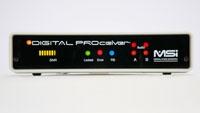Digital IFB brings new advantages for ENG

With the shutoff of the analog spectrum in June, local stations lost a vital wireless channel used for communication between the news director and field crews. Called the ProChannel, this slice of analog spectrum was where stations traditionally transmitted audio data as part of their Interruptible Fold/Feed Back (IFB) systems. In the digital television world, that spectrum goes away.
The FCC reserved part of the 2GHz BAS microwave band for a Data Return Link, which would carry IFB data, but stations have to deploy some type of digitally encoded system to make it work. This will allow news departments to accommodate multiple remote crews reporting live during a single newscast. A number of new technologies have become available to address this and other issues, but deciding which one is best for a particular market can be a challenge.
A broadcast-quality IFB system uses a small part of a local station’s transmission channel to facilitate one-way communication between the producer back at the station and the reporter in the field. The amount of date used is so small, however, that image quality for viewers at home is not affected.
Over the past few years, as stations have moved to digital newsgathering, financial considerations have led to many broadcasters implementing IFB systems based on the Internet Protocol (IP), including cellular hubs installed inside their ENG vehicles. These have worked well in most typical reporting situations, but reliable cell service can be problematic when a major news event breaks. During the most critical hours of a disaster, all types of emergency and government agencies will tie up lines on-site — via Priority Access Service codes — leaving stations to fend for themselves. To date, cellular communication is also not available to helicopter ENG applications.
“I’ve told many news directors, ‘if you depend on cell phones for IFB, I guarantee you that for the biggest story of your career you will not have an IFB connection,’” said Eric Small, chief technology officer of Modulation Sciences, which makes a digital IFB system called the PROceiver. He added that another problem with relying on cell phones is service blockage, which makes connections hard to find in light of heavy public usage. The issue came to light recently during the death of pop star Michael Jackson and in May during a California earthquake.
“The bigger the story, the less cellular bandwidth will be available for stations to use,” Small said. “It’s a fact of ENG life.”
Also, in these tough economic times, the cost of cellular communications limits field crew resources. With remote vehicles often running from early morning newscasts through late evening, the cost of dedicated cellular communications between the studio and several ENG vehicles can easily run as high as $10,000 or more per year.
Up until last year, those costs might have been unavoidable. Now, there is a new generation of digital IFB solutions available from Modulation Sciences and Nucomm that purport to address all of the shortcomings. The units are easy to use and provide ancillary benefits beyond an IFB connection.
Interest has been intense for Modulation Sciences’ IFB systems. The company has shipped about 200 units of its PROceiver system since the summer of 2008. The PROceiver uses MPEG-1 Layer II audio compression to send two channels of high-quality audio IFB communications into the field. Depending upon the configuration, the product uses about 110kb/s of a station’s transport stream. Modulation Sciences sells its IFB box to be paired with a station’s existing encoder, enabling the station to use an unused channel on the encoder for IFB. It’s also compatible with legacy multiplexers and microwave equipment.
“We’ve taken a different approach to IFB, in that we feel IP is not adequate for professional IFB applications,” said Small. “There are a lot of options, but stations should be aware that cost is not the only consideration they should take into account. We chose the MPEG-1 Layer II audio scheme because of the quality it delivers and so that people wouldn’t have to buy a separate encoder. They could use the one they already have.”
The PROceiver also uses special multiplexing software that keeps audio latency to a minimum, from under 100ms to 250ms, according to the company. This is a dramatic improvement over previous generation systems where audio signal delay caused on-air problems. The PROceiver IFB has been used by stations as a program relay device and also as an audio link to remotely control ENG sites. (Modulation Sciences engineers are also working on helicopter applications, but the technology is still in early prototype form.)
Keith Blaisdell, vice president of product development for the Vitec Group (parent to Nucomm), said that even before the analog shutoff, stations have been moving away from using the analog spectrum because a number of new elements have been introduced into the broadcast stream in recent years that caused on-screen dropouts and other errors. This includes Emergency Alert System data and news and weather information displayed at the bottom of the screen. All of these elements, in combination with signal processing, add a small amount of latency to the signal as well. This makes real-time communications with the field crew challenging.
“The days of being able to plug a headset into a TV set are long gone,” said Blasidell. “Over the last decade most stations have gone to some sort of alternative system using the PRO Channel within their analog (NTSC) stream, but that’s not available as we now move to DTV broadcast. More recently broadcasters are either using a two-way radio or some type of cellular phone service.
“During the analog transition days, stations were not so focused on using digital technology because, frankly, the PRO Channel solution was cheaper to accomplish.” Blaisdell said. “With the analog shutoff in June, that spectrum goes away. So reporters have to find other ways of communicating with the home station.”
Nucomm makes an IFB system called ProQ, which includes a Low Latency Audio Multiplexer (LLAM) and a diversity receiver with two antennas. It provides reliable connections — in only 200kb/s of space —for up to eight ENG vans, with separate remote cueing channels. It can also be used to give reporters a tally light in the field, control a remote POV camera (via RS 322), and send a script via an Ethernet connection. And it’s all contained within the same 200kb/s space.
The system’s encoder — placed within the studio-to-transmitter link — multiplexes, or inserts, the audio data within 200kb/ps of the station’s main output stream. A pass-through feature enables a station to continue broadcasting in the event that the ProQ system goes down. Adjustments at the multiplexer can then be made to accommodate different reporters’ IFB needs. The company saw a lot of interest in the ProQ system at the NAB Show in April.
Taking operational expanses into account, Blaisdell said stations should see a return on their investment in a digital IFB system within a year to 18 months. Modulation Sciences’ Small says it could be quicker, depending upon how often it’s used.
Both agree that local stations need a reliable IFB system in order to support a professional newscast and provide viewers with the best on-air news product possible. Now, somebody cue the talent.
Get the TV Tech Newsletter
The professional video industry's #1 source for news, trends and product and tech information. Sign up below.













